Plasma-Activated Acidic Electrolyzed Water: A New Food Disinfectant for Bacterial Suspension and Biofilm
Abstract
:1. Introduction
2. Materials and Methods
2.1. AEW Preparation
2.2. PAW and PA-AEW Preparation
2.3. pH, Oxidation-Reduction Potential (ORP) and Electrical Conductivity (EC) Analysis
2.4. H2O2, NO3− and NO2− Analysis
2.5. RCS and HClO Analysis
2.6. Bacterial and Culture
2.7. Sterilization Effect of Bacterial Suspension
2.8. Sterilization Effect of Bacillus subtilis Biofilm
2.9. Visualization of the Cell Using Fluorescence and Scanning Electron Microscopy
2.10. Statistical Analysis
3. Results and Discussion
4. Conclusions
Author Contributions
Funding
Data Availability Statement
Conflicts of Interest
Abbreviations
| PA-AEW | plasma-activated acidic electrolyzed water |
| AEW | acidic electrolyzed water |
| PAW | plasma-activated water |
| M-AEW | modified AEW |
| RCS | reactive chlorine species |
| RONS | reactive oxygen and nitrogen species |
| KL | killing logarithm |
| ACC | available chlorine concentration |
| ORP | oxidation-reduction potential |
| EC | electrical conductivity |
| TMB | 3,3′,5,5′-tetramethylbenzidine |
| NB | nutrient broth |
| TSA | tryptone soya agar |
| SEM | scanning electron microscopy |
| FL | Fluorescence microscopy |
References
- Mendoza, I.C.; Luna, E.O.; Pozo, M.D.; Vásquez, M.V.; Montoya, D.C.; Moran, G.C.; Romero, L.G.; Yépez, X.; Salazar, R.; Romero-Peña, M.; et al. Conventional and non-conventional disinfection methods to prevent microbial contamination in minimally processed fruits and vegetables. LWT—Food Sci. Technol. 2022, 165, 113714. [Google Scholar] [CrossRef] [PubMed]
- Patra, A.; Prasath, V.A.; Pandiselvam, R.; Sutar, P.P.; Jeevarathinam, G. Effect of Plasma activated water (PAW) on physicochemical and functional properties of foods. Food Control 2022, 142, 109268. [Google Scholar] [CrossRef]
- Niveditha, A.; Pandiselvam, R.; Prasath, V.A.; Singh, S.K.; Gul, K.; Kothakota, A. Application of cold plasma and ozone technology for decontamination of Escherichia coli in foods—A review. Food Control 2021, 130, 108338. [Google Scholar] [CrossRef]
- Ren, Z.; Quan, S.; Gao, J.; Li, W.; Zhu, Y.; Liu, Y.; Chai, B.; Wang, Y. The electrocatalytic activity of IrO2–Ta2O5 anode materials and electrolyzed oxidizing water preparation and sterilization effect. RSC Adv. 2015, 5, 8778–8786. [Google Scholar] [CrossRef]
- Deng, L.; Liu, Y.; Zhao, G.; Chen, J.; He, S.; Zhu, Y.; Chai, B.; Ren, Z. Preparation of electrolyzed oxidizing water by TiO2 doped IrO2-Ta2O5 electrode with high selectivity and stability for chlorine evolution. J. Electroanal. Chem. 2018, 832, 459–466. [Google Scholar] [CrossRef]
- Zhang, C.; Yang, G.; Shen, P.; Shi, Y.; Yang, Y.; Liu, Y.; Xia, X.; Wang, S. Inactivation mechanism of slightly acidic electrolyzed water on Bacillus cereus spores. Food Microbiol. 2022, 103, 103951. [Google Scholar] [CrossRef]
- Rahman, S.M.E.; Khan, I.; Oh, D.-H. Electrolyzed water as a novel sanitizer in the food industry: Current trends and future perspectives. Compr. Rev. Food Sci. Food 2016, 15, 471–490. [Google Scholar] [CrossRef] [Green Version]
- Zhang, W.; Cao, J.; Jiang, W. Application of electrolyzed water in postharvest fruits and vegetables storage: A review. Trends Food Sci. Tech. 2021, 114, 599–607. [Google Scholar] [CrossRef]
- Iram, A.; Wang, X.; Demirci, A. Electrolyzed oxidizing water and its applications as sanitation and cleaning agent. Food Eng. Rev. 2021, 13, 411–427. [Google Scholar] [CrossRef]
- Sun, J.; Jiang, X.; Chen, Y.; Lin, M.; Tang, J.; Lin, Q.; Fang, L.; Li, M.; Hung, Y.-C.; Lin, H. Recent trends and applications of electrolyzed oxidizing water in fresh foodstuff preservation and safety control. Food Chem. 2022, 369, 130873. [Google Scholar] [CrossRef]
- Zhao, L.; Zhao, M.Y.; Phey, C.P.; Yang, H. Efficacy of low concentration acidic electrolysed water and levulinic acid combination on fresh organic lettuce (Lactuca sativa Var. Crispa L.) and its antimicrobial mechanism. Food Control 2019, 101, 241–250. [Google Scholar] [CrossRef]
- Sheng, L.; Shen, X.; Zhu, M.-J. Screening of non-pathogenic surrogates of Listeria monocytogenes applicable for chemical antimicrobial interventions of fresh apples. Food Control 2020, 110, 106977. [Google Scholar] [CrossRef]
- Cichoski, A.J.; Flores, D.R.M.; Menezes, C.R.D.; Jacob-Lopes, E.; Zepka, L.Q.; Wagner, R.; Wagner, R.; Barin, J.S.; Flores, É.M.M.; Fernandes, M.C.; et al. Ultrasound and slightly acid electrolyzed water application: An efficient combination to reduce the bacterial counts of chicken breast during prechilling. Int. J. Food Microbiol. 2019, 301, 27–33. [Google Scholar] [CrossRef]
- Liao, X.; Xiang, Q.; Cullen, P.J.; Su, Y.; Chen, S.; Ye, X.; Liu, D.; Ding, T. Plasma-activated water (PAW) and slightly acidic electrolyzed water (SAEW) as beef thawing media for enhancing microbiological safety. LWT—Food Sci. Technol. 2020, 117, 108649. [Google Scholar] [CrossRef]
- Li, X.; Yue, H.; Xu, S.; Tian, J.; Zhao, Y.; Xu, J. The effect of electrolyzed water on fresh-cut eggplant in storage period. LWT—Food Sci. Technol. 2020, 123, 109080. [Google Scholar] [CrossRef]
- Liu, Q.; Jin, X.X.; Feng, X.; Yang, H.S.; Fu, C.L. Inactivation kinetics of Escherichia coli O157:H7 and Salmonella Typhimurium on organic carrot (Daucus carota L.) treated with low concentration electrolyzed water combined with short-time heat treatment. Food Control 2019, 106, 106702. [Google Scholar] [CrossRef]
- Han, D.; Hung, Y.-C.; Wang, L. Evaluation of the antimicrobial efficacy of neutral electrolyzed water on pork products and the formation of viable but nonculturable (VBNC) pathogens. Food Microbiol. 2018, 73, 227–236. [Google Scholar] [CrossRef]
- Zhang, C.; Zhang, Y.; Zhao, Z.; Liu, W.; Chen, Y.; Yang, G.; Xia, X.; Cao, Y. The application of slightly acidic electrolyzed water in pea sprout production to ensure food safety, biological and nutritional quality of the sprout. Food Control 2019, 104, 83–90. [Google Scholar] [CrossRef]
- Zhang, C.; Li, B.; Jadeja, R.; Hung, Y.-C. Effects of Electrolyzed oxidizing water on inactivation of Bacillus subtilis and Bacillus cereus spores in suspension and on carriers. J. Food Sci. 2016, 81, M144–M149. [Google Scholar] [CrossRef]
- Luo, W.; Wang, J.; Wang, Y.; Tang, J.; Ren, Y.; Gen, F. Bacteriostatic effects of high-intensity ultrasonic treatment on Bacillus subtilis vegetative cells. Ultrason. Sonochem. 2021, 81, 105862. [Google Scholar] [CrossRef]
- Al-Qadiri, H.M.; Smith, S.; Sielaff, A.C.; Govindan, B.N.; Ziyaina, M.; Al-Alami, N.; Rasco, B. Bactericidal activity of neutral electrolyzed water against Bacillus cereus and Clostridium perfringens in cell suspensions and artificially inoculated onto the surface of selected fresh produce and polypropylene cutting boards. Food Control 2019, 96, 212–218. [Google Scholar] [CrossRef]
- Hussain, M.S.; Kwon, M.; Park, E.-ji.; Seheli, K.; Huque, R.; Oh, D.-H. Disinfection of Bacillus cereus biofilms on leafy green vegetables with slightly acidic electrolyzed water, ultrasound and mild heat. LWT—Food Sci. Technol. 2019, 116, 108582. [Google Scholar] [CrossRef]
- Luo, K.; Kim, S.Y.; Wang, J.; Oh, D.-H. A combined hurdle approach of slightly acidic electrolyzed water simultaneous with ultrasound to inactivate Bacillus cereus on potato. LWT—Food Sci. Technol. 2016, 73, 615–621. [Google Scholar] [CrossRef]
- Kim, H.-J.; Tango, C.N.; Chelliah, R.; Oh, D.-H. Sanitization efficacy of slightly acidic electrolyzed water against pure cultures of Escherichia coli, Salmonella enterica, Typhimurium, Staphylococcus aureus and Bacillus cereus spores, in comparison with different water hardness. Sci. Rep. 2019, 9, 4348. [Google Scholar] [CrossRef] [Green Version]
- Zhou, R.; Zhou, R.; Wang, P.; Xian, Y.; Mai-Prochnow, A.; Lu, X.; Cullen, P.J.; Ostrikov, K.; Bazaka, K. Plasma-activated water: Generation, origin of reactive species and biological applications. J. Phys. D Appl. Phys. 2020, 53, 303001. [Google Scholar] [CrossRef]
- Bradu, C.; Kutasi, K.; Magureanu, M.; Puač, N.; Živković, S. Reactive nitrogen species in plasma-activated water: Generation, chemistry and application in agriculture. J. Phys. D Appl. Phys. 2020, 53, 223001. [Google Scholar] [CrossRef]
- Ma, M.; Zhang, Y.; Lv, Y.; Sun, F. The key reactive species in the bactericidal process of plasma activated water. J. Phys. D Appl. Phys. 2020, 53, 185207. [Google Scholar] [CrossRef]
- Zhao, Y.-M.; Patange, A.; Sun, D.-W.; Tiwari, B. Plasma-activated water: Physicochemical properties, microbial inactivation mechanisms, factors influencing antimicrobial effectiveness, and applications in the food industry. Compr. Rev. Food Sci. Food Saf. 2020, 19, 3951–3979. [Google Scholar] [CrossRef]
- Han, J.-Y.; Song, W.-J.; Kang, J.H.; Min, S.C.; Eom, S.; Hong, E.J.; Ryu, S.; Kimd, S.B.; Cho, S.; Kang, D.-H. Effect of cold atmospheric pressure plasma-activated water on the microbial safety of Korean rice cake. LWT—Food Sci. Technol. 2020, 120, 108918. [Google Scholar] [CrossRef]
- Frías, E.; Iglesias, Y.; Alvarez-Ordóñez, A.; Prieto, M.; González-Raurich, M.; López, M. Evaluation of Cold Atmospheric Pressure Plasma (CAPP) and plasma-activated water (PAW) as alternative non-thermal decontamination technologies for tofu: Impact on microbiological, sensorial and functional quality attributes. Food Res. Int. 2020, 129, 108859. [Google Scholar] [CrossRef]
- Liao, X.; Bai, Y.; Muhammad, A.I.; Liu, D.; Hu, Y.; Ding, T. The application of plasma-activated water combined with mild heat for the decontamination of Bacillus cereus spores in rice (Oryza sativa L. ssp. japonica). J. Phys. D Appl. Phys. 2020, 53, 064003. [Google Scholar] [CrossRef]
- Xu, Z.; Zhou, X.; Yang, W.; Zhang, Y.; Ye, Z.; Hu, S.; Ye, C.; Li, Y.; Lan, Y.; Shen, J.; et al. In vitro antimicrobial effects and mechanism of air plasma-activated water on Staphylococcus aureus biofilm. Plasma Process Polym. 2020, 17, e1900270. [Google Scholar] [CrossRef]
- Los, A.; Ziuzina, D.; Boehm, D.; Cullen, P.J.; Bourke, P. Inactivation efficacies and mechanisms of gas plasma and plasma-activated water against Aspergillus flavus spores and biofilms: A comparative study. Appl. Environ. Microb. 2020, 86, e02619-19. [Google Scholar] [CrossRef] [PubMed]
- Royintarat, T.; Choi, E.H.; Boonyawan, D.; Seesuriyachan, P.; Wattanutchariya, W. Chemical-free and synergistic interaction of ultrasound combined with plasma-activated water (PAW) to enhance microbial inactivation in chicken meat and skin. Sci. Rep. 2020, 10, 1559. [Google Scholar] [CrossRef] [Green Version]
- Charoux, C.M.G.; Patange, A.D.; Hinds, L.M.; Simpson, J.C.; O’Donnell, C.P.; Tiwari, B.K. Antimicrobial effects of airborne acoustic ultrasound and plasma activated water from cold and thermal plasma systems on biofilms. Sci. Rep. 2020, 10, 17297. [Google Scholar] [CrossRef]
- Lin, C.-M.; Hsiao, C.-P.; Lin, H.-S.; Hsieh, C.-W.; Wu, J.-S.; Hou, C.-Y. The antibacterial efficacy and mechanism of plasma-activated water against Salmonella enteritidis (ATCC 13076) on shell eggs. Foods 2020, 9, 1491. [Google Scholar] [CrossRef]
- Liu, C.; Chen, C.; Jiang, A.; Sun, X.; Guan, Q.; Hu, W. Effects of plasma-activated water on microbial growth and storage quality of fresh-cut apple. Innov. Food Sci. Emerg. 2020, 59, 102256. [Google Scholar] [CrossRef]
- Inguglia, E.S.; Oliveira, M.; Burgess, C.M.; Kerrya, J.P.; Tiwar, B.K. Plasma-activated water as an alternative nitrite source for the curing of beef jerky: Influence on quality and inactivation of Listeria innocua. Innov. Food Sci. Emerg. 2020, 59, 102276. [Google Scholar] [CrossRef]
- Xiang, Q.; Zhang, R.; Fan, L.; Ma, Y.; Wu, D.; Li, K.; Ba, Y. Microbial inactivation and quality of grapes treated by plasma-activated water combined with mild heat. LWT—Food Sci. Technol. 2020, 126, 109336. [Google Scholar] [CrossRef]
- Bai, Y.; Muhammad, A.I.; Hu, Y.; Koseki, S.; Liao, X.; Chen, S.; Ye, X.; Liu, D.; Ding, T. Inactivation kinetics of Bacillus cereus spores by Plasma activated water (PAW). Food Res. Int. 2020, 131, 109041. [Google Scholar] [CrossRef]
- Machado-Moreira, B.; Tiwari, B.K.; Richards, K.G.; Abram, F.; Burgess, C.M. Application of plasma activated water for decontamination of alfalfa and mung bean seeds. Food Microbiol. 2021, 96, 103708. [Google Scholar] [CrossRef]
- Wang, Q.; Salvi, D. Evaluation of plasma-activated water (PAW) as a novel disinfectant: Effectiveness on Escherichia coli and Listeria innocua, physicochemical properties, and storage stability. LWT—Food Sci. Technol. 2021, 149, 111847. [Google Scholar] [CrossRef]
- Ashrafudoulla, M.; Mizan, M.F.R.; Park, S.H.; Ha, S.D. Current and future perspectives for controlling Vibrio biofilms in the seafood industry: A comprehensive review. Crit. Rev. Food Sci. Nutr. 2020, 61, 1827–1851. [Google Scholar] [CrossRef]
- Worthington, R.J.; Richards, J.J.; Melander, C. Small molecule control of bacterial biofilms. Org. Biomol. Chem. 2012, 10, 7457–7474. [Google Scholar] [CrossRef] [Green Version]
- Roy, P.K.; Mizan, F.R.M.; Hossain, M.I.; Han, N.; Nahar, S.; Ashrafudoulla, M.; Toushik, S.H.; Shim, W.-B.; Kim, Y.-M.; Ha, S.-D. Elimination of Vibrio parahaemolyticus biofilms on crab and shrimp surfaces using ultraviolet C irradiation coupled with sodium hypochlorite and slightly acidic electrolyzed water. Food Control 2021, 128, 108179. [Google Scholar] [CrossRef]
- Bridier, A.; Sanchez-Vizuete, P.; Guilbaud, M.; Piard, J.C.; Naitali, M.; Briandet, R. Biofilm-associated persistence of food-borne pathogens. Food Microbiol. 2015, 45, 167–178. [Google Scholar] [CrossRef]
- Han, Q.; Song, X.; Zhang, Z.; Fu, J.; Wang, X.; Malakar, P.K.; Liu, H.; Pan, Y.; Zhao, Y. Removal of foodborne pathogen biofilms by acidic electrolyzed water. Front. Microbiol. 2017, 8, 988. [Google Scholar] [CrossRef] [Green Version]
- Shiroodi, S.; Schwarz, M.H.; Nitin, N.; Ovissipour, R. Efficacy of Nanobubbles Alone or in Combination with Neutral Electrolyzed Water in Removing Escherichia coli O157:H7, Vibrio parahaemolyticus, and Listeria innocua Biofilms. Food Bioprocess Technol. 2021, 14, 287–297. [Google Scholar] [CrossRef]
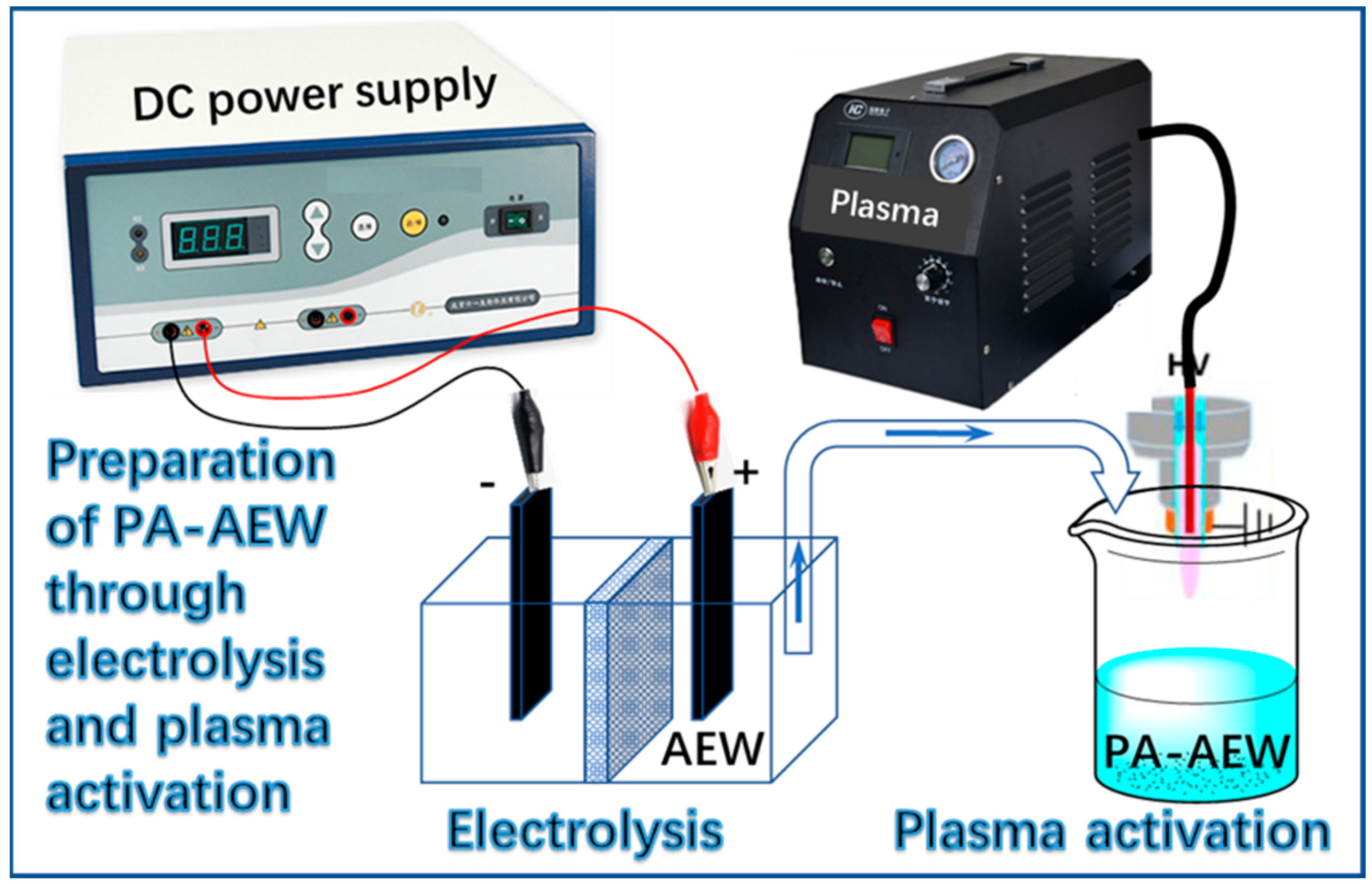
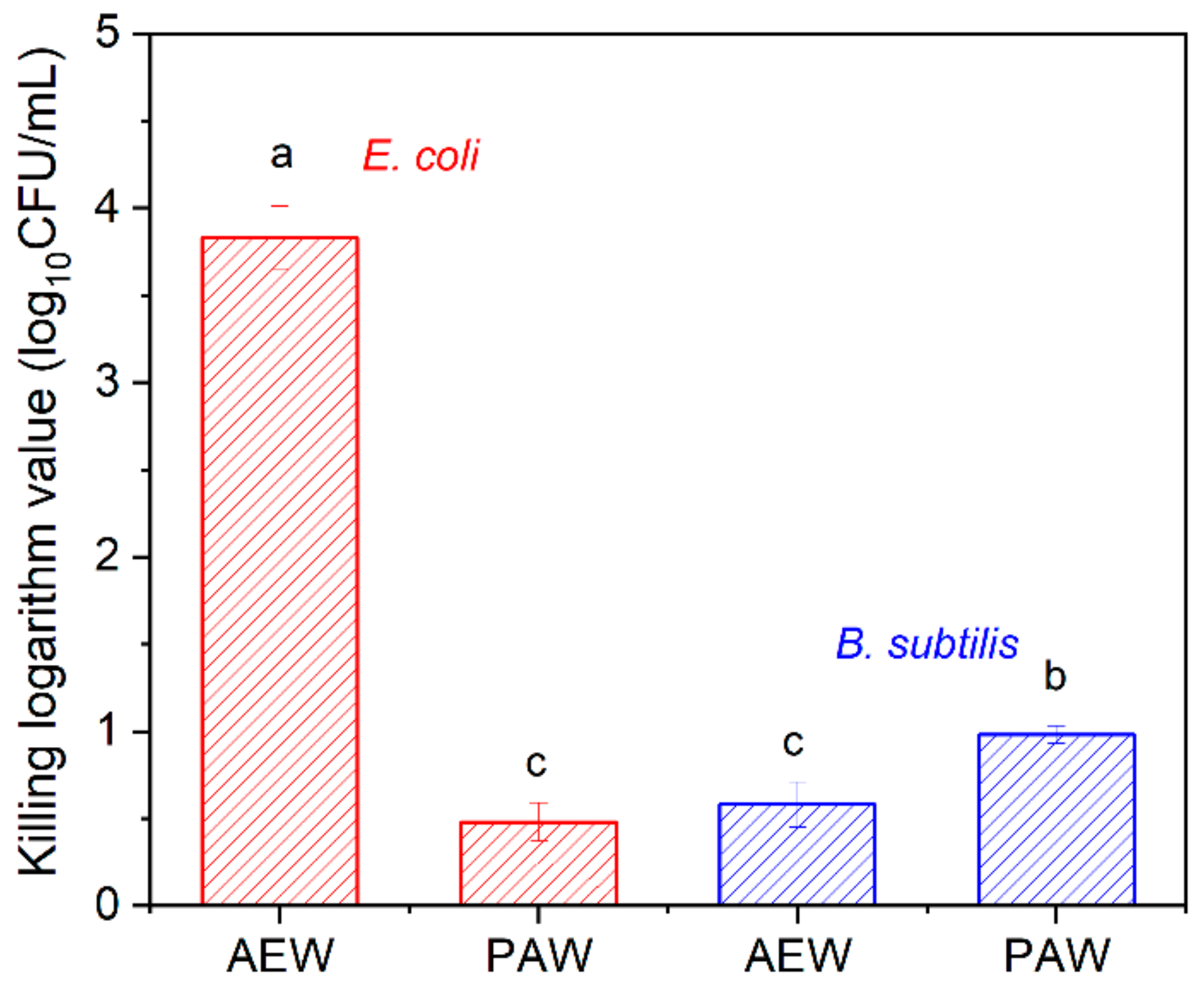

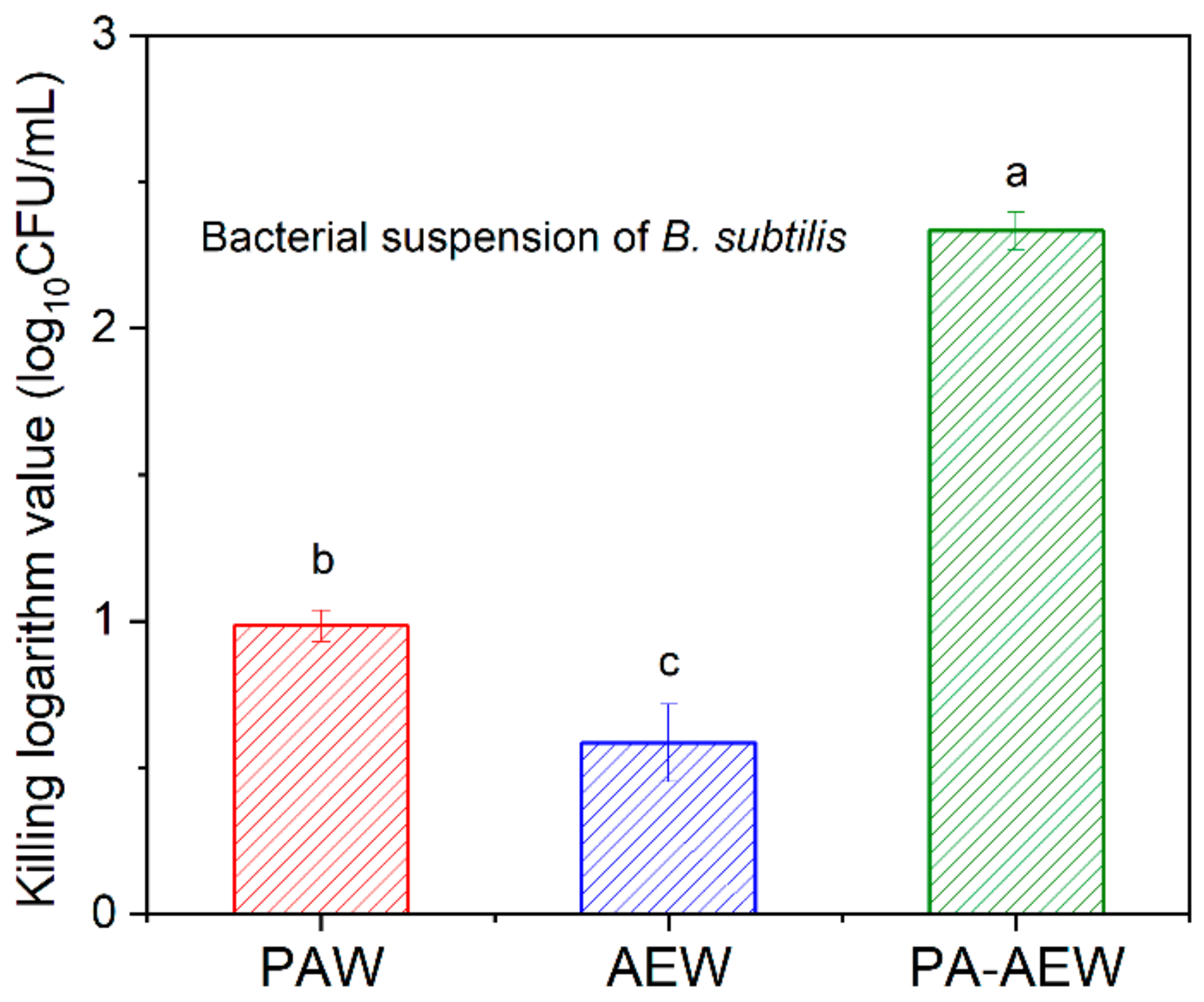
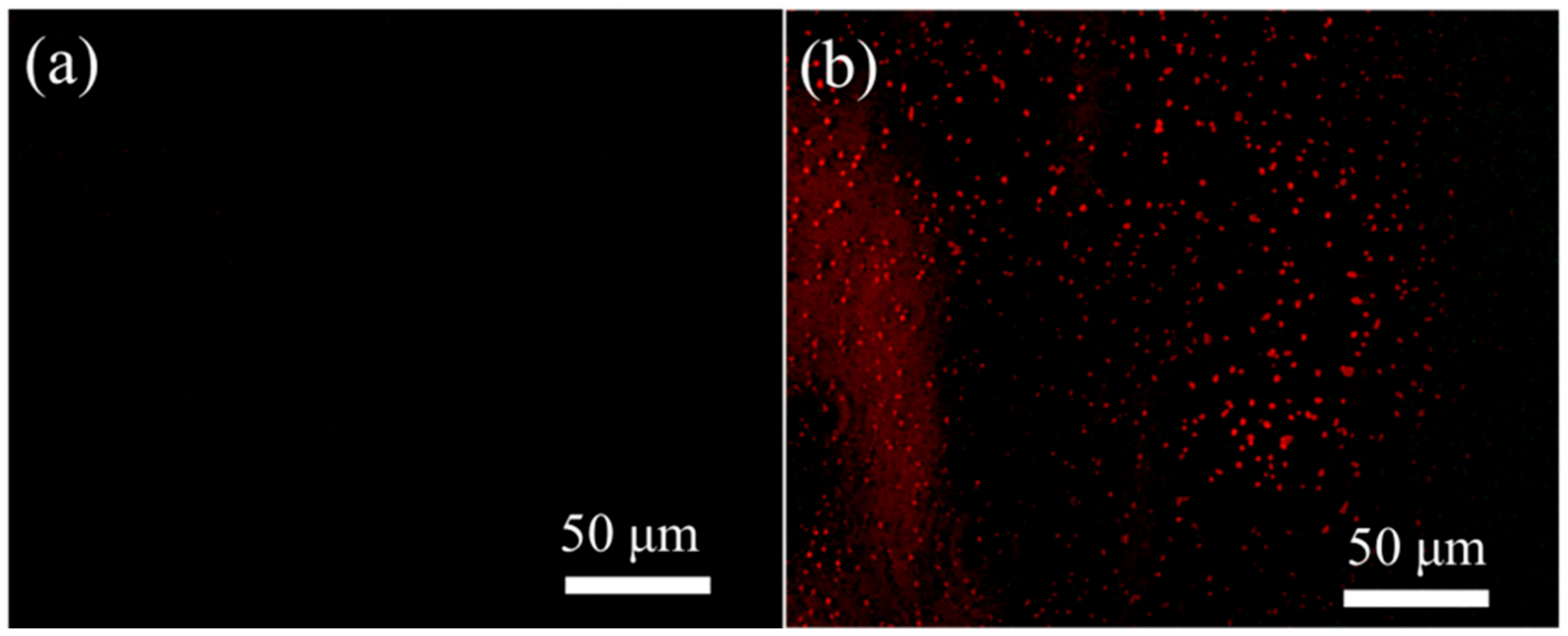
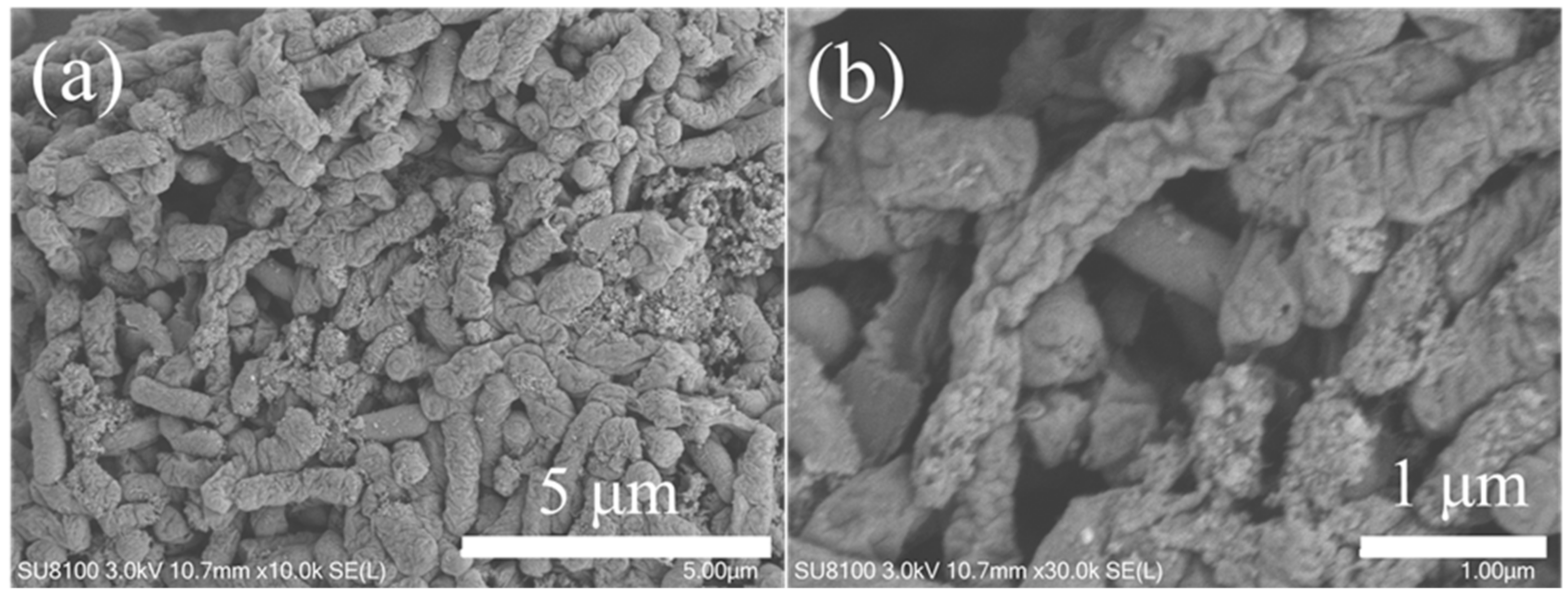
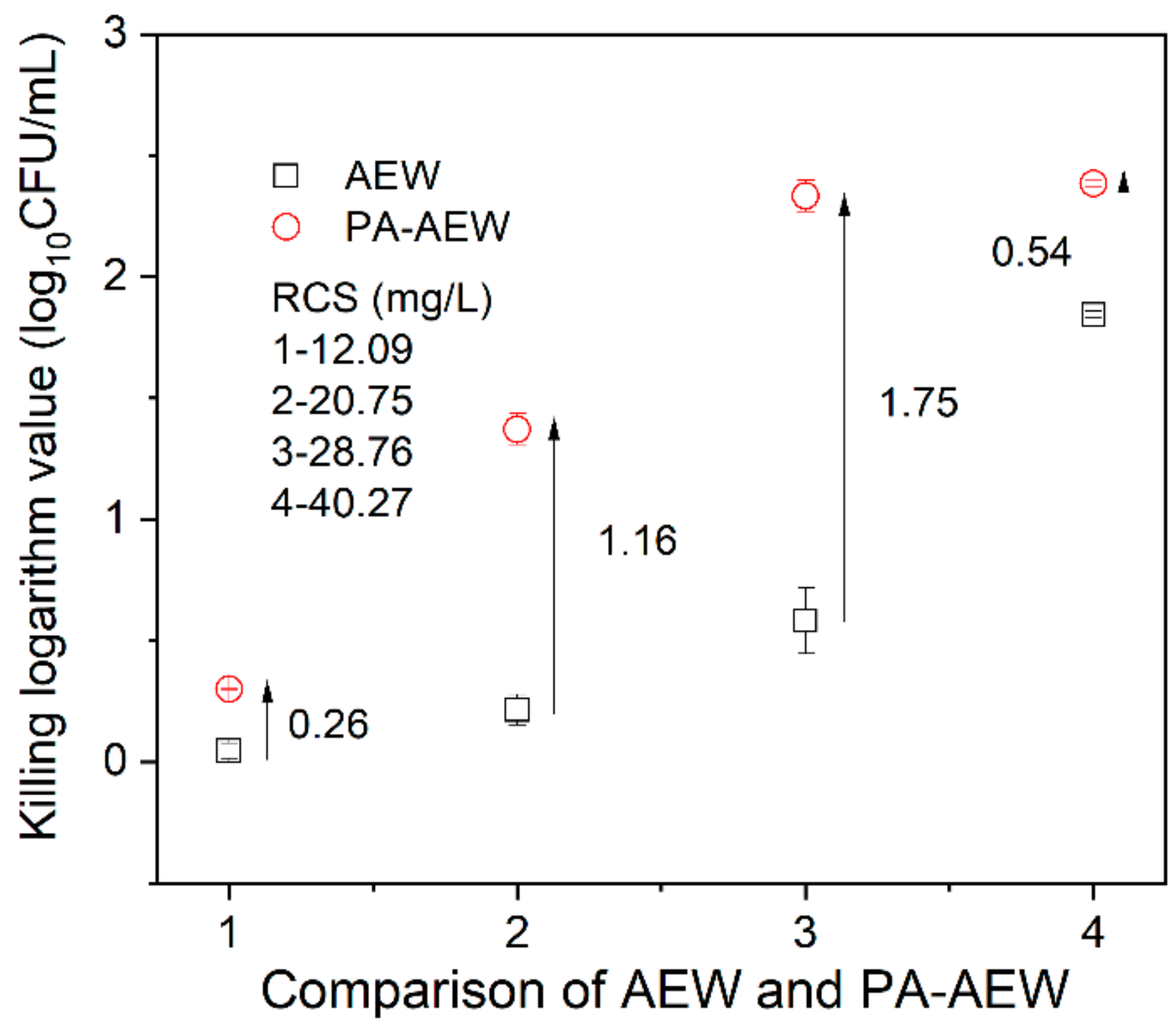
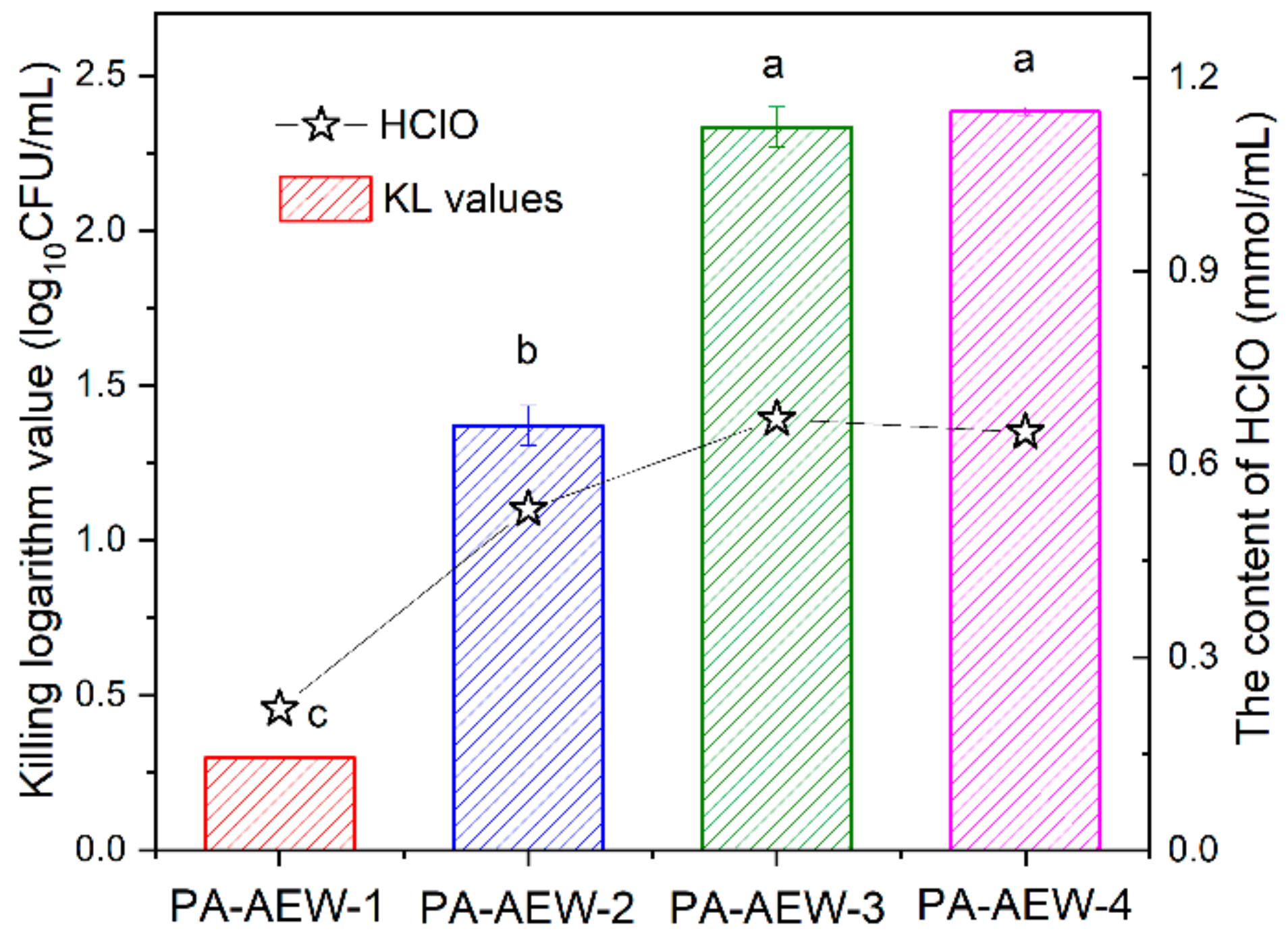
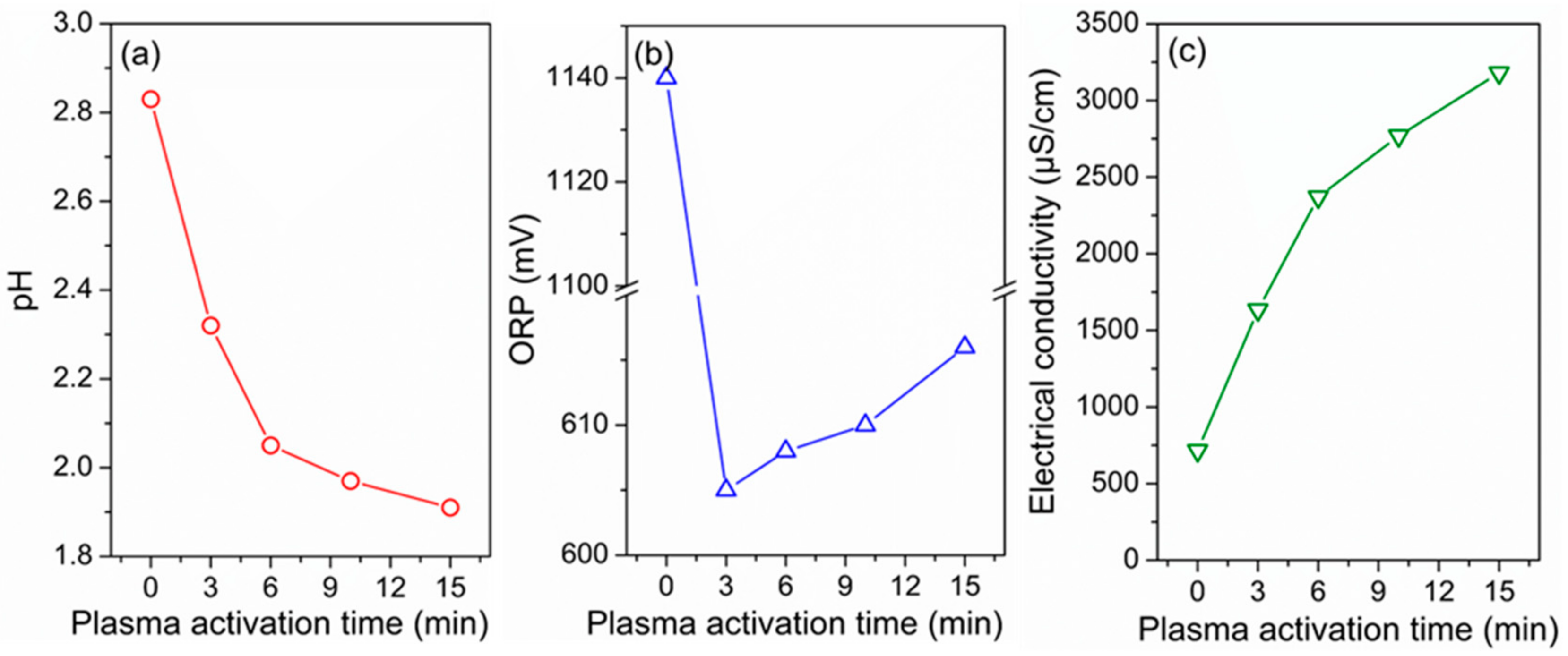
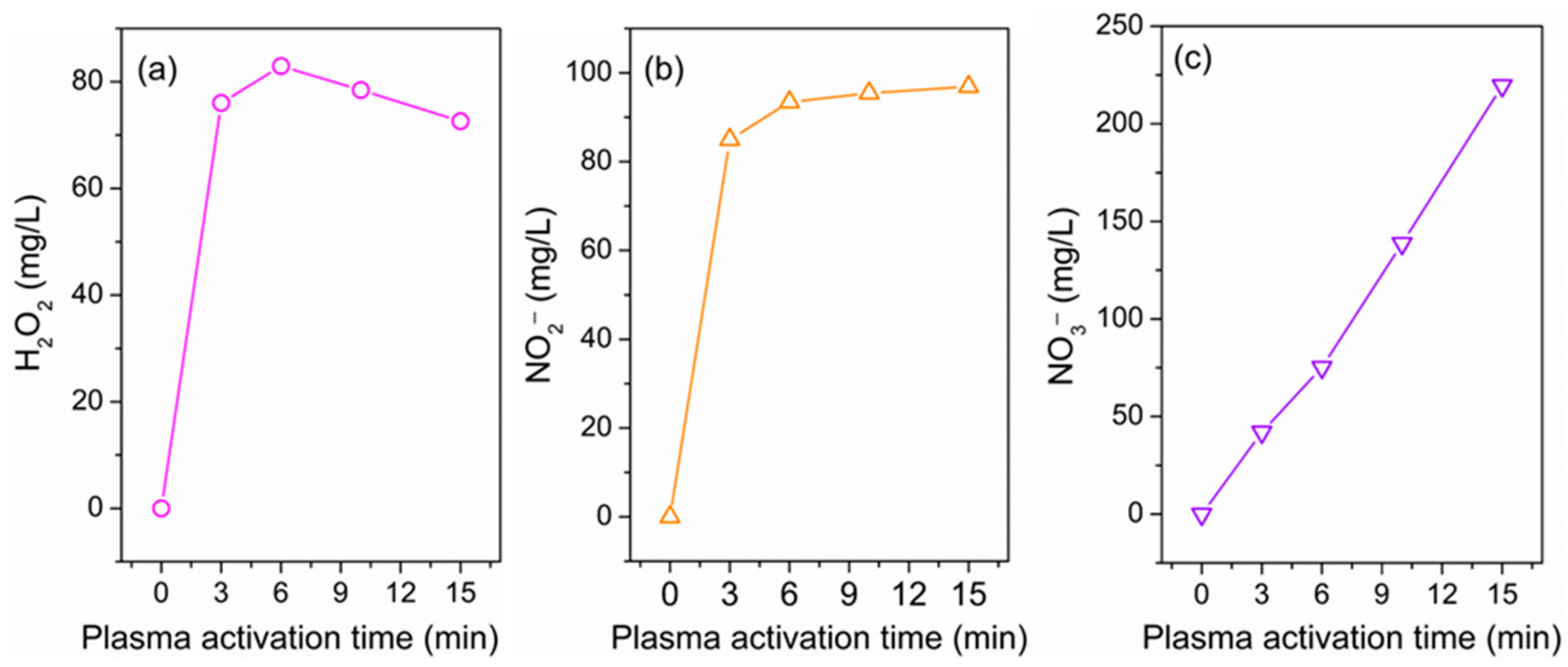
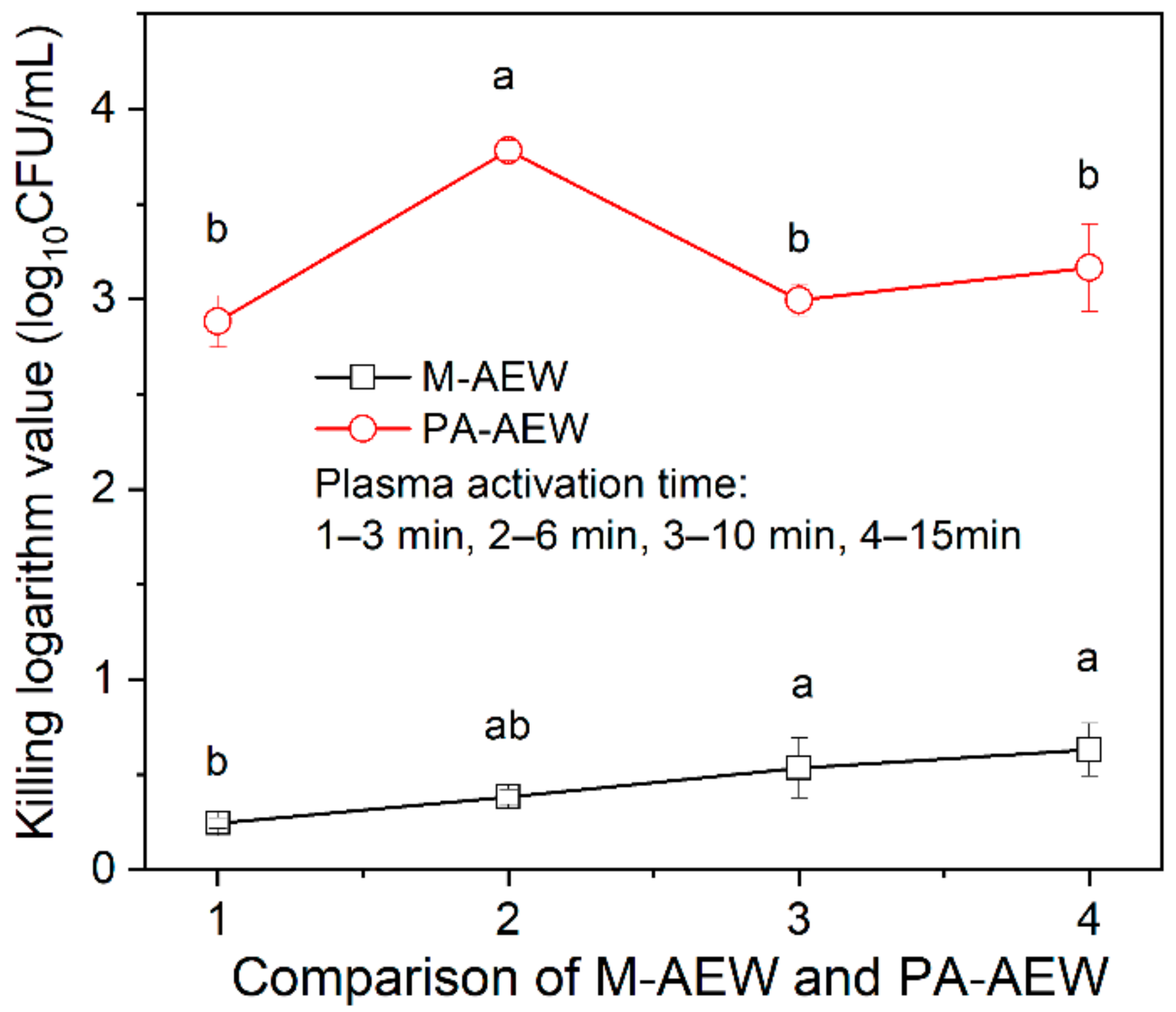
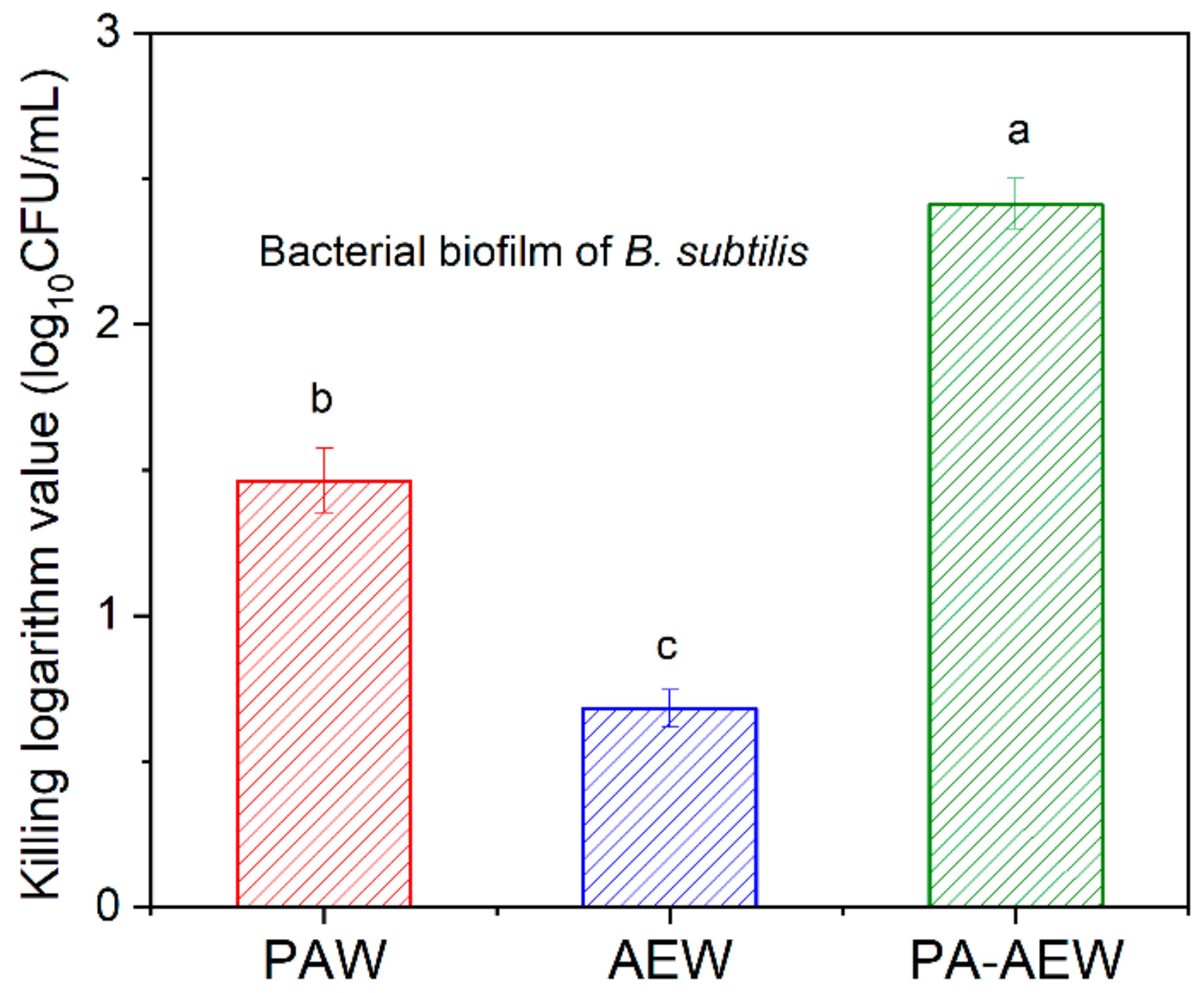
Publisher’s Note: MDPI stays neutral with regard to jurisdictional claims in published maps and institutional affiliations. |
© 2022 by the authors. Licensee MDPI, Basel, Switzerland. This article is an open access article distributed under the terms and conditions of the Creative Commons Attribution (CC BY) license (https://creativecommons.org/licenses/by/4.0/).
Share and Cite
Heng, Y.; Wang, M.; Jiang, H.; Gao, S.; Zhang, J.; Wan, J.; Song, T.; Ren, Z.; Zhu, Y. Plasma-Activated Acidic Electrolyzed Water: A New Food Disinfectant for Bacterial Suspension and Biofilm. Foods 2022, 11, 3241. https://doi.org/10.3390/foods11203241
Heng Y, Wang M, Jiang H, Gao S, Zhang J, Wan J, Song T, Ren Z, Zhu Y. Plasma-Activated Acidic Electrolyzed Water: A New Food Disinfectant for Bacterial Suspension and Biofilm. Foods. 2022; 11(20):3241. https://doi.org/10.3390/foods11203241
Chicago/Turabian StyleHeng, Yaping, Ming Wang, Hongwei Jiang, Shumin Gao, Jin Zhang, Jinlin Wan, Tingji Song, Zhandong Ren, and Yuchan Zhu. 2022. "Plasma-Activated Acidic Electrolyzed Water: A New Food Disinfectant for Bacterial Suspension and Biofilm" Foods 11, no. 20: 3241. https://doi.org/10.3390/foods11203241
APA StyleHeng, Y., Wang, M., Jiang, H., Gao, S., Zhang, J., Wan, J., Song, T., Ren, Z., & Zhu, Y. (2022). Plasma-Activated Acidic Electrolyzed Water: A New Food Disinfectant for Bacterial Suspension and Biofilm. Foods, 11(20), 3241. https://doi.org/10.3390/foods11203241





